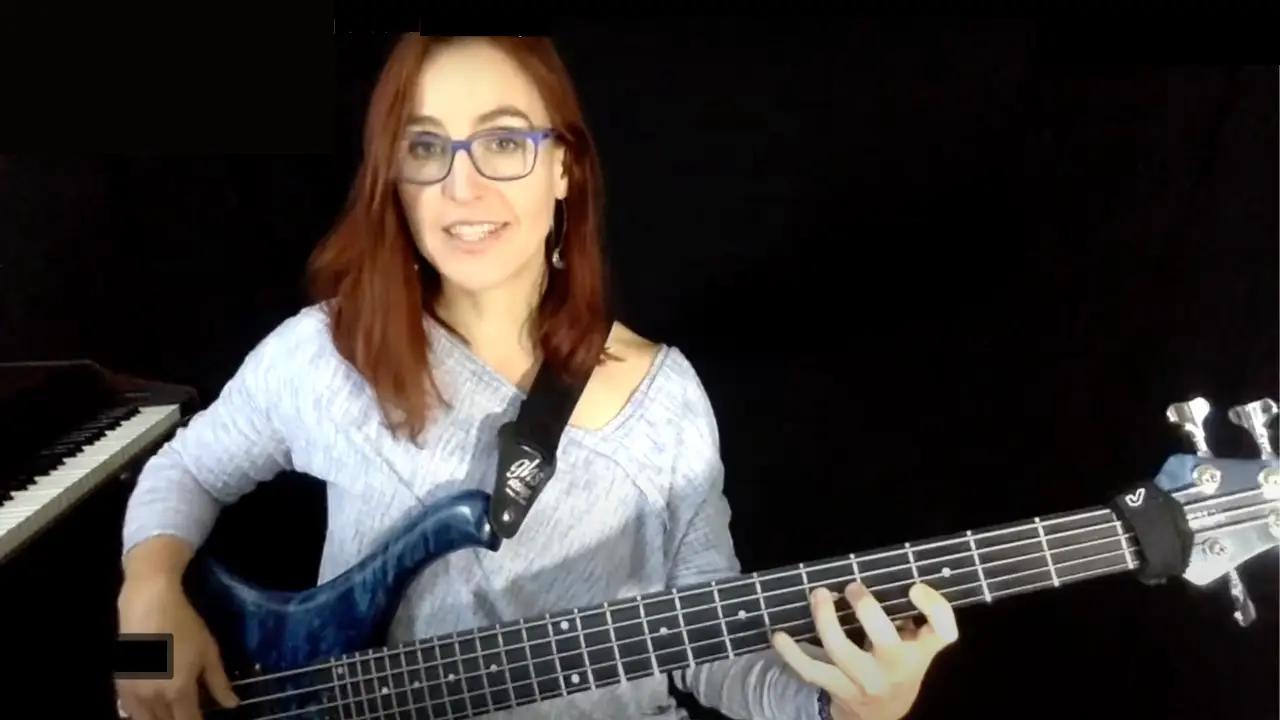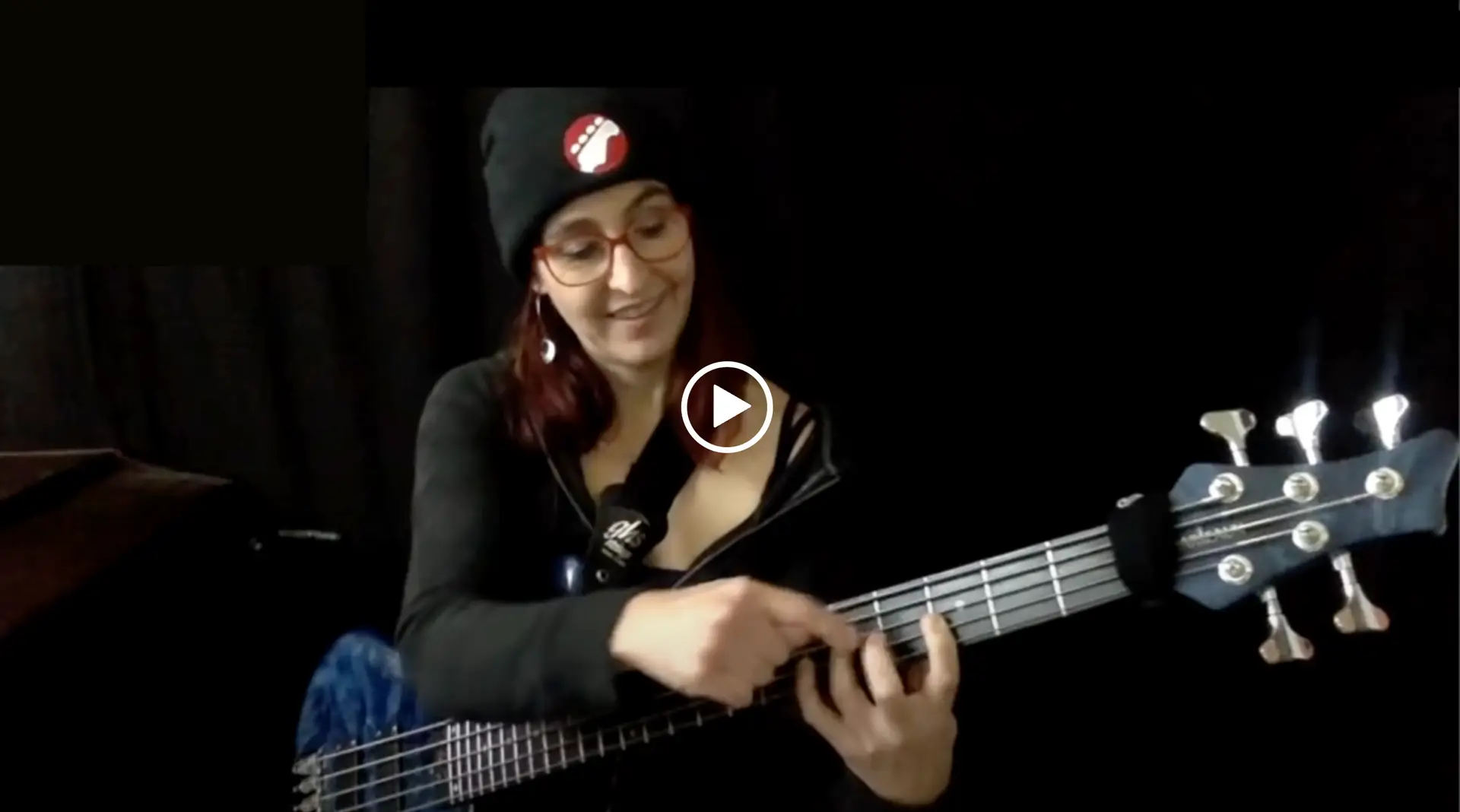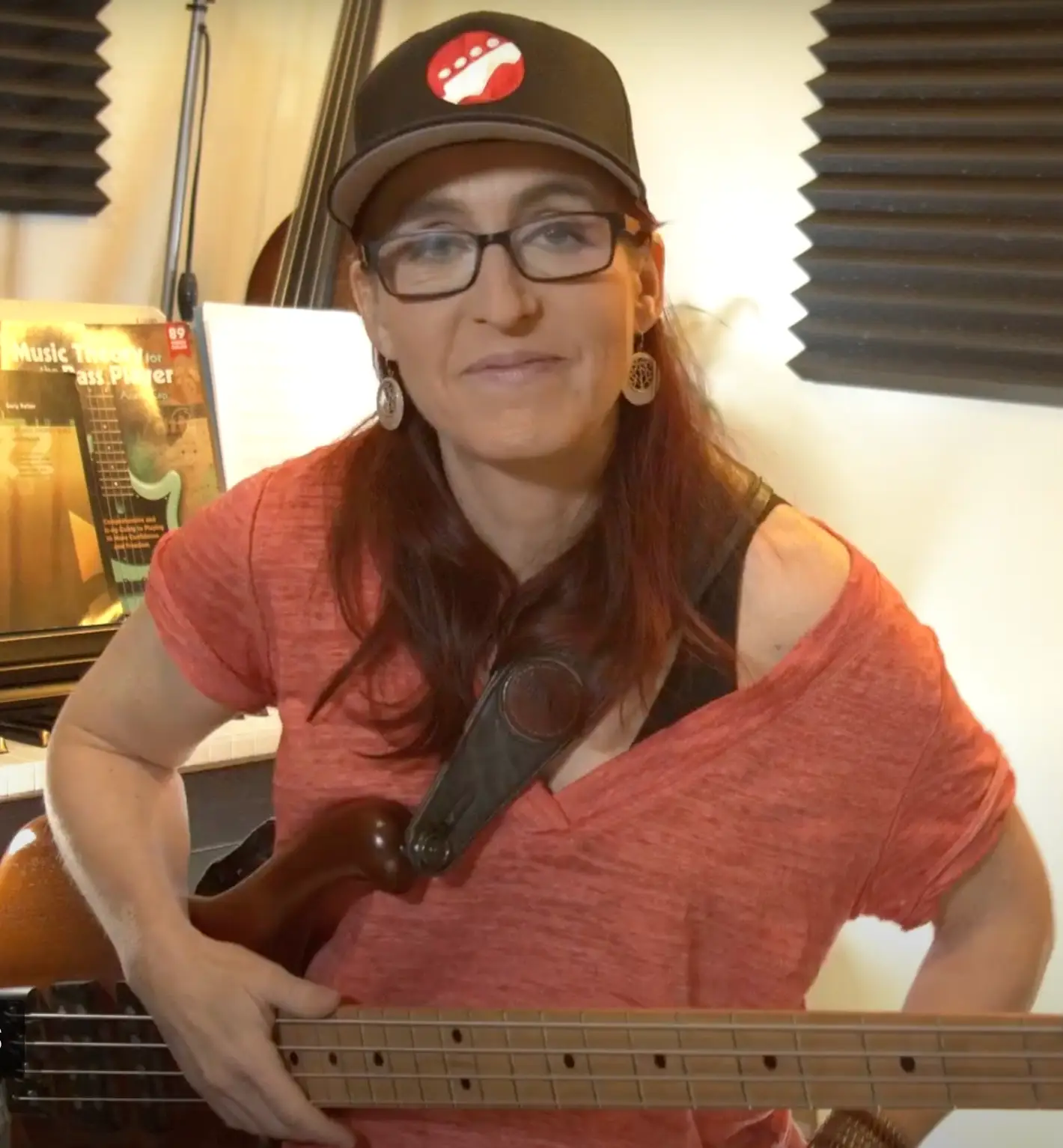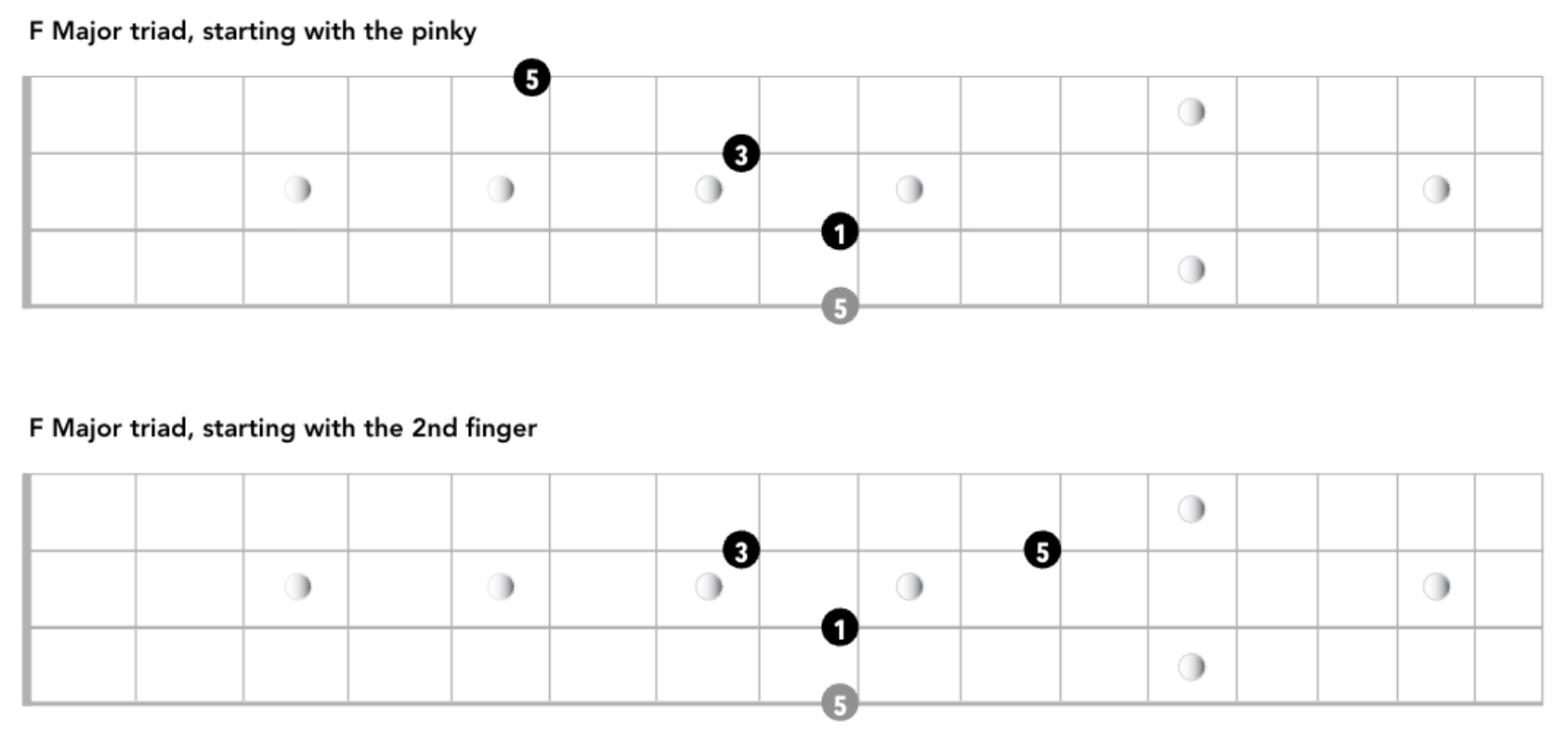Welcome to Bass Bit #1, with an Introduction and a Free Lesson on Notes!
This one is quite a bit longer than most of the bits will be because I go a little bit into my reasoning behind my book and my method of teaching music theory first and reading second.
As for the bass bit part I will be tackling a few excerpts from the book from page 6, bringing you exercises and a lesson on notes.
Even though this starts very basic, it moves fast.
A real brain twizzler exercise starts at the 14:11 mark.
More information about me.
More information about the book.
I am working on several options to study with me online. Requests range from specialized applications to help for a structured approach. Until all is sorted I can offer a few slots on google/skype. If you are interested to learn more, please click here.
TRANSCRIPT:
Bass Bit #1
Hello and welcome! My name is Ariane Cap and you have found arisbassblog.com. You’re watching the Bass Bits and this is Bass Bit no. 1. My name is Ariane Cap and if you’d like to find out more information about who I am – what I do as a player, as an educator – please just click below, there are some resources for you there.
I call this particular part of my blog the Bass Bits, bite-sized video lessons that will demonstrate concepts laid out in my book. My book is called “Music Theory for the Bass Player” and it recently came out. Maybe you’re here because you’ve scanned its QR code or have seen references in the book about arisbassblog. Welcome and thank you for being here.
What is it about?
I will go through concepts laid out in this book. I want to tell you a little bit about this book and how it came about. I originally wanted to write a different book – a book about the pattern system, which is a systematic way to get the fret board under your belt and it’s coming. But as I was preparing for it and pulling all the materials that I’ve used for many years with my students, I realized I wanted to use music theory terms such as scales, certain intervals, notes, triads, and chords, and so forth. And I was looking for a book that I could point to that would lay out music theory on the fret board. As I was doing research about music theory books, I realized that a lot of music theory books are not really about the music that bass players typically play. So there’s a little bit of a disconnect there and oftentimes these books are geared towards maybe a classical piano player, or they’re just kept in general terms.
And to me, I think music theory can be really integrated if you do it on the instrument. A lot of my students kept voicing things akin to: “well there’s this extra thing called music theory – that it’s almost like it’s killing my creativity or it’s taking away from what I wanna do or express on the instrument.”
I was thinking a lot about that and I think part of why that comes about is maybe because the learning of music theory happens disconnected from the fret board. So I wanted to address that. The other thing I wanted to address is that sometimes bass players might not be that great of sheet music readers. It’s because a lot of bass players come to the instrument through learning shapes or picking bass lines off of a recording and they are maybe not used to reading score very well.
And, if you try to learn to read at the same as you’re trying to understand music theory, that’s a big chunk to bite off! and, also, in my view it’s a different skill. So a lot of music theory books – because they have a different goal – they start with, “this is whole note, this is a half note”, and before you know it, you’re into pages and pages of arpeggios and scales that you’re required to read. To me, it’s a bit of a missed opportunity because you might be struggling with just the plain reading part of it. And reading is an extremely vital skill – absolutely needs to be studied. However, if you know music theory reading gets much easier so I would do it the other way around! I would learn music theory first and reading second.
The other argument is that, a lot of bass players learn through shapes – they learn through listening, picking things off the recording, or they learn through certain shapes they get under their fingers and then execute them and move them around on the bass. It’s a missed opportunity to study music theory without really addressing these shapes.
So that was a bit of the background of why I wrote this book because I wanted to address all of that. My book doesn’t’ rely on standard notation. I do use tab once in a while because I use tiny little bit of a standard notation but it’s mostly for some examples and they’re optional. Mostly, I rely on fret board diagrams because they’re visual representations of what we actually do.
As I was doing that, I realized just how important fingering and technique are, so this book has an extensive section on fingerings and technique because good technique is very important for good sound. And while I don’t wanna tell you exactly how to hold your fingers as everybody has a different physique and is put together differently, there are some principles that can really help you and also some exercises that can help you accelerate your playing, lead to more relaxed playing.
It can also make sure that you don’t injure yourself and get any kind of negative long term effects from playing this instrument, which is heavy and has some physical components to it. So it’s all about relaxation, feeling into your body, and finding what works for your specific body. I have a lot of tips, techniques, exercises, and photos in the book that describe what I’m talking about. I also have an extensive section about how to help you change your habits, should you have bad habits because I hear that request a lot.
So, I wanna get started. That was just a little bit of background and today is Bass Bit No. 1! In my blog, I will be doing lots of different things but the Bass Bits, they’re reserved for “Music Theory for the Bass Player” and we’ll be going through chapter by chapter, or concept by concept. You don’t absolutely need the book to follow along. What I’m doing here is just a tiny or a small part of what is in the book. I should also mention if you would like to study at length with me, I do longer videos and they are going to be available in my course and coaching classes. So please, again, check the resources below if you’d like to study with me or go a little bit more into depth about some of these concepts. You can do that as well.
Alright, so I’m gonna be starting very basic and I’m gonna be moving along quite fast. If you’re a beginner – and you need to read by it, need to read things up in the book – that might be a good way to go. If you’re an advanced player, there might be some ways here to think about stuff that you’ve never thought about in a certain way or some exercises that actually might be quite challenging even if you are a seasoned player.
So very basically, there are seven notes in the musical alphabet – A, B, C, D, E, F, G, and then it repeats. That’s one thing to know. The other thing to know is that between E and F, and B and C, is a half step. Half step in our western tonal system is the shortest distance. A half step for a bass player is in its simplest form (there’s more to say [playing: 7.14 to 7.21] about that), but in its simplest form it’s just going up or down a fret – half step up, half step down. A whole step, double the whole thing – [playing: 7:22 to 7.25] whole step up, whole step down. There are open strings, you can move between different strings – we’ll get to that. But for now, that’s number one that we need to know.
The next thing are sharps and flats. So, if between all the letter names (for example between [playing: 7.39 to 7.40] A and B – are whole steps, that means there’s a half step [playing: 7.43 to 7.44] in between and that one is named either by using a sharp or by using a flat sharp like a point goes up. So if I say [playing: 7.53 to 7.54] A#, then the note gets higher. Higher is this way, higher is this way, and higher is also this way [pointing].
For a beginner, this is extremely confusing because this is exactly opposite as it is in space. But in music we go by sonically by what we’re hearing and this way [playing: 8.17 to 8.18] notes get higher and typically, [playing 8.19 to 8.20] this way notes get higher. Of course, if we involve different strings, that’s not always true but we’ll get to that.
Half steps, as I was saying – between E and F, as well as B and C; all the other half steps we create by using sharps and flats. I can take [playing 8.34 to 8.36] a sharp make my A# to get me in between A and B, or I can take the [playing 8.40 to 8.42] B and make a flat to lead to a Bb. So here’s an exercise for you: you’re gonna go up the [playing 8.52] E string, saying every single note name as you go up.
[playing 8.56 to 9.09] E – F – F# – G – G# – A – A# – B – C – C# – D – D# – E.
So far so good. Now, you’re going down. You notice I’m doing this in tempo. That’s extremely important. If you don’t do it in tempo, this is what may happen:
[playing 9.17 to 9.24] E – F – F# – G – G# … (think, think, think, think, think)
In those think, think, think, think, think pauses, you’re cheating yourself out of the practice. What I recommend to do is: you find your slowest, your toughest spot and that gives you the tempo. If between [playing: 9.41 to 9.42] B and C is hard, and you need to think [playing: 9.44] about it for a second, then you need to give yourself more time. Now I always do these exercises with a metronome and I really do recommend you do them religiously with a metronome because without it, you’re cheating yourself out of the success of the exercise. You’re actually training yourself to have bad or sloppy timing, for one, and you’re also training yourself to think, “There’s time, I’ll figure it out.”
In music, the best skill you can train yourself to do is the skill to think ahead in time because music happens in time. If you don’t know that after [playing: 10.19 to 10.22] A, or after A follows A# – if you don’t know it in time, it doesn’t matter if you know it three notes later, because the rest of the band will have moved on by then. That’s why I highly recommend to not cheat yourself out of that in this type of exercise. If it’s too hard, you just take the tempo down. I recommend rather than setting the metronome to a glacial tempo of forty, where it’s like “tik, tok”, you don’t really get a sense of a beat. Although there are great exercises to do with that sort of metronome setting as well, for this kind of exercise: set it to a tempo seventy or eighty where you really get a nice sense of a beat going by. If that’s too fast, you let two beats go by. So you would go…
[playing 11.06 to 11.12] E *click F *click F# *click G *click…
Or you let two beats go by if that’s too fast…
[playing: 11.14 to 11.20] E *click *click F *click *click…During that time, you think about it, you think what’s next.
[playing: 11.22 to 11.27] F# *think *think (what’s next? Oh G. Okay, that’s easy. G# is next)…
If you need four clicks, that’s fine. Wherever you are that’s cool, but don’t cheat yourself out of the full effect by doing it in time! Don’t go [playing: 11.33 to 11.37] “Oh I’m rocking it down here, and once I’m getting up here, it’s slowing me down a little bit.” That means you’re not doing yourself a favor! Keep the metronome going, let it go by three or four beats, and you will be forced to be consistent and you’ll be forced to be in time – which are all great skills to have and you’ll be forced to think ahead. So in that pause where that metronome goes click and click, you think ahead what’s coming next.
So, going up with sharps, we’ve done that. So far so good. And then we go down, saying flats, it’s easy:
[playing 12.07 to 12.19] E – Eb – D – Db – C – B – Bb – A – b – G – Gb – F and E.
For completeness sake, I should say that there is also such a thing as a double sharp and a double flat. We will see later where we might need that; however, for now, just know that an F double sharp will take you up a whole step. So an Fx [playing: 12.38 to 12.40] is basically a G. Also, you may have noticed, these guys [playing: 12.44 to 12.46] in between the whole steps, they have two note names – [playing: 12.47 to 12.48] F# or G flat. That’s called enharmonic. That’s a really good term to know. An F# [playing: 12.53] enharmonically is a Gb. It’s just a matter of how I look at it; as you learn more music theory, you will realize that it’s actually much easier to know how to name things correctly because they make much more sense that way. They feel like a chunk of knowledge that you can plug into rather than something you have to think about each time. It will be automatic to think in certain ways, in certain keys that there are sharps and in other keys there are flats and it will be much easier ‘cause you’re not picking out single notes, you’re sort of plugging into a pool of knowledge which is a scale or a key, for example.
Now I’m gonna step this up one more time and this is where it may get a little harder. Now we’re gonna go up again and say everything that’s not just the letter name, but something that needs a sharp or a flat because I’m in between things. I’m gonna give that a flat name as I go up. So let’s do that. So my clicks are running and I’m gonna go:
[playing 13.46 to 13.56] E – F – Gb– G – Ab – A – Bb – B – C – Db – D – Eb – E…
And you guessed it, going down and we’re gonna do the reverse, so now it’s gonna be sharps, so:
[playing: 14.00 to 14.09] E – D# – D – C# – C – B – A# – A – G# – G – F# – F – E.
Alright, if you wanna step it up one more time, how about we say it going up with all sharps including double sharps? It’s just a great mental exercise to get your seven notes in gear.
[playing 14.24 to 14.37] Dx – E# – F# – Fx – G# – Gx– A# – Ax – B# – C# – Cx – D# – Dx
And go now, we’re gonna do everything in flats and double flats…
[playing 14.41 to 14.54] Fb – Eb – Ebb – Db – Dbb – Cb – Bb – Bbb – Ab – Abb – Gb – Gbb and Fb.
Do that on all of your strings, just for the exercise of it. It’s fun, it’s a brain teaser! Set a metronome, you’ll come up with lots of variations for this. I highly recommend it, it’s an interesting exercise and it will help you get the fret board down.
Now in the next Bass Bit, I’m gonna show you that, if you think you knew the alphabet, maybe you are mistaken. We’re gonna scramble up the alphabet in wicked ways! Why, what does it do? It helps you understand how notes relate to each other! And that is a very useful thing to know, especially when we go further using those note names. So on the fret board, knowing them and seeing them and realizing how they relate to each other – that’s gonna be the topic for next week.
Thank you so much for tuning in. Welcome again to the Bass Bits! I love hearing from you. Please leave me a comment, let me know, if you have any questions down below or on the site – there are comment buttons, so please let me hear from you. I love knowing how it’s going and I will see you in the next Bass Bit.
 Played on my five string Consat Custom Marleaux, Dean Markley Strings, through my TC Electronic BG 250 208.
Played on my five string Consat Custom Marleaux, Dean Markley Strings, through my TC Electronic BG 250 208.
I use Marleaux Basses and Dean Markley Strings. Fretwraps by Gruvgear, pedals, amps, cabs by TC Electronics. (Official endorser of all these fine companies).
Thanks to Wolftrackaudio.com for audio post production.









22 Replies to “Bass Bit 1: Free Lesson on Notes (BB#1)”
I received the book yesterday. It’s amazing. I think that’s it’s the best book that I have found. Cheers!
Thank you, Diego. happy to hear! Any questions please holler. All the best!
Hello,
I am starting playing bass, first instrument for me :-), love it so far but i really need something like your book. So i have ordered it today :-), soon i’ll have it and start immediately.
Thanks for all your works.
Hope you are getting on great with the book. Sorry I missed your comment! Cheers
Ari
Hi Ariane, be playing bass for thirty years by ear and a wing and a prayer.Bought your book Music Theory for the bass player Just looked at your exercise using double sharps and flats and my brain melted. I have high hopes this will get my lazy a** into gear and actually learn something!
Nice to hear from you. All I can say is go for it and have fun. Gxx B# (that’s my initials in doublesharps 😉 )
I am 70 and have been playing bass by ear since 1962. I bought your book to learn theory and know my bass better. Played all cover tunes in the 60’s when they were new and for 15 years in a classic rock band until I “retired” in 2013. I believe I might be the poster boy for “Who this book is for” on page 3. I probably have a dozen bass books but believe this is the one I’m going to get the most out of. I am interested in videos and building a basic understanding of theory. I want to understand theory within the next six months and learn to read music. Is that realistic?
Absolutely realistic. I am working on putting together a 20-week course where we go through the book together. Would that be of interest? There would be a weekly check-in, homework, Q and A’s and peer support. Up your alley?
Ps: so cool, you been groovin since the early days of electric bass. Fab! My oldest student here is 76. She is on oxygen and comes to lesson every week. She rocks.
Ok, that is so awesome! And Phil, I’m 57, originally a trombone player, but I’ve decided to learn bass and take up piano seriously, finally, now. No time like today! You are now a new music hero of mine (as is the 76 yr old student of Ari’s). Thanks for the inspiration. You and others like the two of you have recently fueled my inspiration to reclaim my musical talent and passion for music that was too long ignored until recently. It’s never too late.
Ari, thank you too for your motivation and faith in us out here choosing to commit to the bass.
Hitting the LIKE button 🙂 Thumbs up!
I read you are putting together a 20 week course on your book where we can go through it together I would be interested in doing that let me know love the way you wrote this book thanks
Great thank you. Make sure to sign up for my newsletter at the homepage here. I will send info about the twenty weeks soon.
Hi Ariane
I caught part of your lesson on SBL live this week, and came to your blog to learn more. I have ordered your book today, really keen to improve my playing and knowledge – excellent introduction video 🙂
Tim 😀
Thanks so much, Tim, nice to hear from you
Hi, Ari,
I just did Bass Bit#1, and I must say it’s an excellent supplement to the book and moving along on the studies in general. Love your teaching style. Hadn’t realized there were so many available already, so I’m psyched about continuing with the rest. Thank you for all this excellent instruction.
Cheers, Jose, thank you for all your nice comments! I am working on a guided 20 week course with assignments emailed into your inbox, it willl also point to the correct videos at the right chapter in the book. In the meantime if you are looking for videos for the book, search for the “Bass Bits” 🙂
Nice to meet you and welcome on board!
Hi Ariane. Just received a copy of your book this week. Only on chapter 2 but love it so far. I’ve been playing on and off (more off than on over the last 10 years) for over 25 years, but already feel that I’m getting a more intimate, and instinctive, understanding of the fretboard. I would definitely be interested in the 20 week course. Thanks for everything you’ve taught me so far 🙂
Cheers Andy, great to hear 🙂
I’m interested in taking your 20 week course. Please email information on sign up, course cost, any pertinent info I need to get started. I’m a bassist with 48 years pro experience and trumpet background that helps me in theory, but I’ve reached a bit of stagnation in my bass learning so I think you may be able to help me expand my knowledge on the instrument. Thanks, Ron
Please check this link: arisbassblog.com/coaching-course/
We offer a fifteen-day hassle-free money back guarantee so you can test drive the course up to unit three and see if it is for you. I encourage you to check it out for yourself. You retain life time access and can go at your own speed.